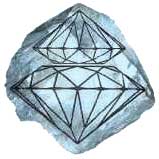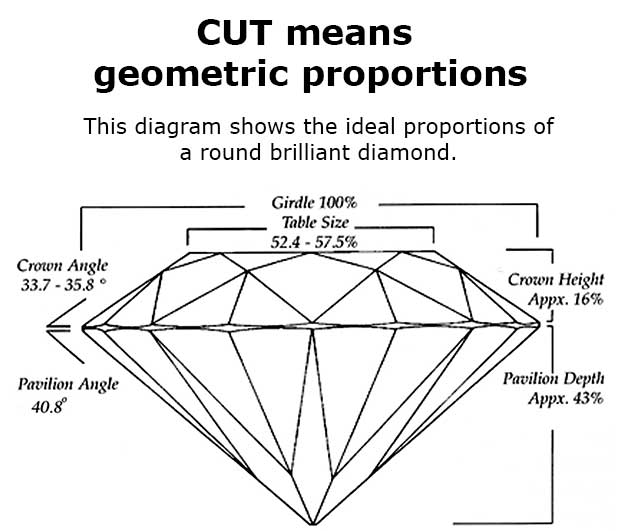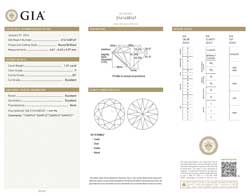Exploring the 4 Cs:
Carat Weight & Cut are a team
 Carat weight gets a lot of attention, but hardly anyone mentions cut — which for the valuation of diamond is the most important of the 4 Cs !
Carat weight gets a lot of attention, but hardly anyone mentions cut — which for the valuation of diamond is the most important of the 4 Cs !
What is a gem's "cut," anyway? When we see "cut" it usually refers to the gem's shape, rather than to the cutting characteristics of the gem's shape.
And what's the carat connection?
Carat Weight
 Carat weight gets a lot of attention, but hardly anyone mentions cut — which for the valuation of diamond is the most important of the 4 Cs !
Carat weight gets a lot of attention, but hardly anyone mentions cut — which for the valuation of diamond is the most important of the 4 Cs ! Carat weight is a term everyone recognizes as an indication of the diamond's size. The word carat comes from the carob bean, which weighs about 1/5 of a gram and was used as a measure in earlier times. So a carat is 1/5 of a gram. Stones lighter than a carat are measured in points. There are 100 points in a carat, so a point is equal to .01 ct. It's very straightforward.
Carat weight is important because the bigger the gem, the better, right? Not necessarily. In determining value, color and clarity play their parts, as discussed in our previous two issues. But when it comes to diamond, cut has the biggest role.
Cut can be responsible for as much as half of a diamond's valuation!
Cut
Despite its place in "the 4Cs", cut is almost a secret. It is hardly ever mentioned in jewelry advertisements, on sales documents, on online auction sites, or even on appraisals. Yet for diamond, cut is crucially important in assigning value.
Cut, when speaking of the four qualities that give diamonds their value, refers to the geometric proportions of the gem.
 The geometric proportions are critical because a diamond is a prism that refracts, or bends, light rays, breaking white light into the colors of the rainbow. It is this refraction that unleashes the color spectrum in a way that gives a diamond its fire. The optical proportions must be exact in order to achieve maximum brilliance and scintillation.
The geometric proportions are critical because a diamond is a prism that refracts, or bends, light rays, breaking white light into the colors of the rainbow. It is this refraction that unleashes the color spectrum in a way that gives a diamond its fire. The optical proportions must be exact in order to achieve maximum brilliance and scintillation.
For some time gemologists have recognized the best proportions for a round brilliant diamond ("round brilliant" is the most popular shape for diamonds).
It isn't necessary for insurers to understand these proportions as a gemologist does. What is important for insurers is to be aware that cut proportions are precise measurements and they dramatically affect a diamond's valuation.
Why is Cut rarely disclosed?
 Bigger is not necessarily better
Bigger is not necessarily betterIn cutting a gem from rough stone, waste is inevitable. The average weight loss from rough to finished gem is about 50 percent.
In this illustration, the figure on the left shows two well-proportioned gems cut from a piece of diamond rough. The right figure shows how the same piece of rough could yield two larger stones.
Because consumers often shop by carat weight, many diamonds are deliberately cut to increase their carat weight at the expense of their beauty.
Not disclosing cut proportions makes comparison shopping difficult. Basing a purchase decision on carat weight and price, a consumer may choose a larger, poorly cut stone, thinking it is a bargain.
(The Shopping Checklist on our consumer site encourages customers to compare cut proportions of diamonds they are considering, and to discuss all the gem's qualities with their jeweler or appraiser.)
Ultimately, consumers will buy what they like. But should a loss occur, the insurer should not replace a poorly cut diamond with a well-cut stone of comparable weight, color and clarity. Conversely, the insurer should not replace a well-cut stone with a poorly cut stone, though that poorly cut stone may be larger. The replacement should be comparable in all 4 Cs.
For accurate valuation and replacement of a round brilliant diamond, a term like "excellent" or "ideal" is not a sufficient description of cut. The insurer should have the proportions of the gem.
Lab reports
Gems on all scheduled jewelry should have lab reports, to verify what is on the appraisal and to supply information that may be missing.
Even though appraisals usually don't include cut info, reports from reliable gem-grading labs should!
Not all gem-grading labs are the same.
See below for links to reliable gem-grading labs.
This discussion of cut has dealt with round brilliant diamonds because a standard has been set for the proportions that show a diamond to best advantage. Diamonds of other shapes have no agreed-upon standard.
FOR AGENTS & UNDERWRITERS
Cut plays a crucial part in valuation of a diamond. Two finished diamonds, equal in all respects except cut proportions, can vary as much as 50 percent in price.
Cut proportions may be given on a diagram, as shown on the lab report above. Or the terms table size, crown angle, etc., may be listed along with their percentages. Either presentation is acceptable.
Some appraisals may try to pull a fast one with a term such as "Princess Cut." Don't be fooled—this is the name of the shape, it does not describe the "cut" that is one of the 4Cs crucial to valuation.
You may also see something like "Cut: Excellent." Such terms are not useful — you want the actual cut proportions.
Gems on scheduled jewelry should be accompanied by a report from a reliable lab.
Reputable labs for verifying reports you receive:
GCAL https://www.gcalusa.com/certificate.html
GIA https://www.gia.edu/report-check-landing
AGL https://www.aglgemlab.com/contact
These labs all produce diamond reports that include cut proportions.
AGL and GCAL also produce colored gem reports that include cut proportions, but GIA does not.
Note: Gem-grading labs usually offer various versions of reports, with higher priced reports giving more information. Layouts may also vary. Check to be sure the reports you receive have descriptions of all 4Cs.
Look for cut information on a diagram (as in the report pictured here). Or look for a list of cut terms: table size, crown height, crown angle, girdle, pavilion angle and pavilion depth, along with their percentages.
A lab report is not a substitute for an appraisal. It is independent verification of the gem's qualities, and it may supply information missing from the appraisal.
FOR ADJUSTERS
When pricing replacements, look for cut information on all appraisals and diamond reports. Ignore words like excellent or very good, as these are too vague to be of much use. Look for the numbers.
For a damage claim, have the gem inspected in a gem lab to determine cut proportions (as well as to verify other qualities) before settling the claim. Remember that cut accounts for as much as 50% of a diamond's value.
©2000-2025, JCRS Inland Marine Solutions, Inc. All Rights Reserved. www.jcrs.com



